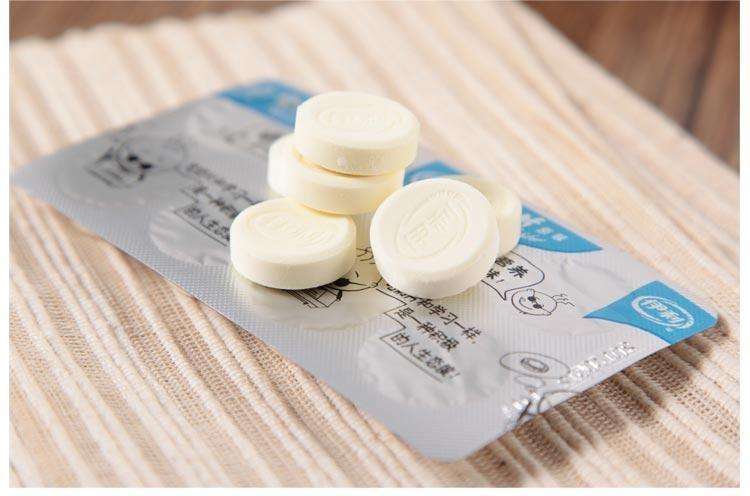Milk tablet, as processed products of milk and instant snack containing rich nutrient, is compressed from milk powder, vegetable creamer, whey protein powder and sucrose. Currently, 90% milk tablets are packed in flat blisters for transport and storage convenience.

Flat blister packing, also named press through packaging (or PTP), means that materials are first filled into blisters which are sucked, blown or molded. Then alu foil covers formed blisters and they are heat sealed under certain pressure and temperature and in certain time. Main covering material is alu foil containing 99% calendered electrolytic aluminum. It is the metal material of the largest using amount in packaging. It has no toxicity or smell, but can be moisture-proof, air-protective, flavor-retentive and light-proof. These features enables it to protect packed materials most effectively. One side of foil is printed and coated with protective agent, while the other side is not printed but coated with adhesion for its easy heat seal with formed blisters. Protective agent can prevent surface of alu foil from oxidation and deterioration and prevent ink on alu foil from falling or contacting adhesion and polluting materials... On the other hand, adhesion should coat alu foil uniformly for satisfying sealing performance of blister packing. Most blisters are made of PVC or PVDC sheet. PVDC is better than PVC in preventing water vapor, gas or light, while PVC is cheaper. Since some materials are not sensitive to water, oxygen and light, PVC + alu foil is a suitable packing combination.
In practical production, milk tablets contains large amount of protein and fat. Therefore, their easy oxidation and deliquescence will influence their nutritional value and even generate bad smells and blocks. To avoid the above problems and prolong shelf life of milk tablets, high-resistance materials and select sealing techniques can be applied for protection.
1. Performance of covering materials
Covering materials is mainly made up of alu foil, which is a packing material of high resistance. Exist of pinholes causes the most serious defect for foil penetrability. During packaging, transport and storage of milk tablets, rubbing and squeezing seems to be inevitable, which will enlarge pinhole size or scope and even generate obvious crease. Gas and water vapor can penetrate through them so that stability of alu foil is influenced.
Generally speaking, two methods can be used to judge pinhole or resistance of covering materials. First, based on rubbing during transport, covering materials can be rubbed by rubbing tester. Then turpentine can be used to detect pinhole quantity of the material. The other one is to detect covering material resistance before and after rubbing. Figures can reflect resistance change directly. Scientific quantitative experiments can help objective evaluation on anti-rubbing performance and adaptability of covering materials, as well as to provide persuasive data reference for selection of these materials.
2. Performance of formed blisters
Blister package is composed of covering material and formed blister. It is affected by production process, techniques, equipment and some other possible factors. The resistance of a complete blister is not simply a sum of resistance of two materials. Take resistance to water vapor as an example. Two common blister materials and end blisters are selected for experiment. They are numbered 1#PVC, 2#PVC/PVDC and have no obvious defect.
Testing method: Blister materials are tested according to Test Method for Water Vapor Transmission of Plastic Film and Sheet - Cup Method (GB 1037), and formed blisters according to Determination of Water Vapor Transmission Rate Through Dry Packages - Modulated Infrared Sensor (GBT 31355-2014)
Testing instruments: W3/060 water vapor transmission rate testing system (cup method), W3/230 water vapor transmission testing system (modulated infrared sensor)
The testing result is shown in table 1:
Water vapor transmission rate (WVTR) |
Testing target | Blister materials (g/m2·24h) | Formed blisters (g/pkg·day) |
Temperature | 23°C | 38°C | 23°C | 38°C |
1# | 2.401 | 6.519 | 0.0015 | 0.0039 |
2# | 0.795 | 3.024 | 0.0006 | 0.0010 |
Remarks: Diameter of round sheet of blisters materials is 7.4cm. |
Table 1
These testing figures shows that WVTR of both blister material and formed blister increases as temperature rises. From perspective of molecular thermal motion, water molecule will moves more fiercely due to temperature rising, so expansion of water vapor speeds up. Meanwhile, molecular chain conformation of blister materials changes more frequently, cohesion of polymer is weakened and path between paralleled molecular chain broadens. Therefore, water molecules can expand more easily. These two changes lead to weakened moisture-prevention of both blister materials and formed blisters in high temperature.
Suppose that surface area of formed blisters is 5cm2, WVTR of 1# blisters can be estimated to 3g/m2·24h in 23°C and 2# formed blisters 1.2g/m2·24h, according to the above table. Obvious difference between estimated result and testing figure reflects that resistance of blister materials also changes during processing and forming. As a result, it is one-sided and inaccurate to see WVTR of formed blisters as that of blister materials simply.
3. Control to heat sealing quality of covering material and blister material
All above, blister materials are heat sealed with one adhesion-coated side of covering material. Its good heat seal quality is a critical factor to make sure that every blister is airtight and independent from each other. Therefore, other blisters will not break when one blister is opened so that milk tablets can be protected from moisture, deterioration or breaking. On the other hand, these phenomena occur when heat sealing parameters and techniques are not correct. Another reason leading to these phenomena is non-uniform thickness of alu foil. It further influences uniformity of adhesion coating so that sealing quality is not as expected. Therefore, reasonable heat sealing parameters and stronger control to heal sealing quality can help avoid production of the above mentions inferior products to the utmost extent.
Common quality control method in lab is: Heat sealing temperature is controlled at around 155±5°C, heat sealing pressure at 0.5MPa and heat sealing time at 1s, by HST-H6 heat sealing tester. Then three 15mm-wide strips at the center of the sample are picked for the test on heat sealing intensity. The two ends of strips are held by fixtures of XLW (M) intelligent electronic tensile tester with proper tension. Besides, the axis of strips should coincide with the center line of the two fixtures of the machine. The testing speed is set at 200mm/min. Then the experiment can be started. At last, the machine will calculate and record experiment figures automatically.
4. Conclusion
Blister package for milk tablets might be damaged during storage and transport due to reduction of their resistance to oxygen and water vapor, as well as poor sealing between covering material and formed blisters. Relevant tests and analysis can show that not all blister materials can keep their resistance after forming and WVTR of blister materials and formed blisters can increases as temperature rises. Besides, too much pinholes of alu foil and unqualified heat sealing quality will also increases moisture and air transmission rate of formed blisters. A suggestion is that milk tablets producers can control and test the above performances of blisters more strictly for longer shelf life and higher quality of milk tablets.

 English
English









